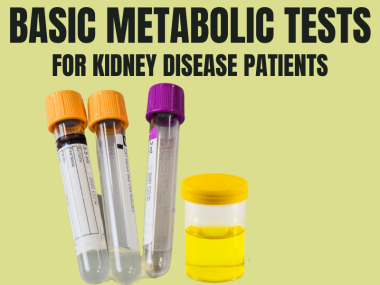Metabolic acidosis refers to the build-up of acids in your blood, a common occurrence in advanced CKD patients.
Fortunately, we can diagnose, monitor, and treat metabolic acidosis.
Though a consequence of poorly functioning kidneys, metabolic acidosis can itself cause worsening of the kidney function, starting a vicious cycle: kidney damage—acidosis—more kidney damage—more acidosis.
Fortunately, we can diagnose, monitor, and treat metabolic acidosis.
What is Metabolic Acidosis?
Acidosis means the acid accumulation in the blood, best measured by blood pH level. The normal range of pH in the blood is 7.35 to 7.45. When pH drops below 7.35, it is called acidosis.
Our body works like a giant factory with numerous sections, where each part processes the raw material to build something while producing a certain amount of waste. When our body processes food material, it breaks up the macronutrients into smaller units, which are then used to build and repair the cells. These productive proceedings, however, produce some waste material. A major one is carbon dioxide. Roughly ninety percent of this CO2 travels in the blood as bicarbonate (HCO3-). For all practical purposes, bicarbonate is used as the marker of acid in the blood for CKD patients.
Normal range of bicarbonate is 22-29 mEq/L.
Normal range of bicarbonate is 22-29 mEq/L. This regulation of bicarbonate requires two organs in good health: The lungs and kidneys. Lungs exhale the extra acid in the form of carbon dioxide; kidneys manage the acidity by excreting, reclaiming, or even producing more bicarbonate.
However, when eGFR falls below 30m/min, kidneys can no longer excrete the waste products of metabolism as efficiently, losing their capacity to maintain the bicarbonate level within the normal range. As a result, acidity ensues, soon followed by its complications, calling for measures to interrupt this cycle.
Signs and Symptoms of Acidosis
A little acidosis might not get noticed, but as its severity increases, it manifests as bodily changes that can affect your daily life.
Patients with metabolic acidosis usually feel weak, unable to do their daily activities, carrying a sense of tiredness all the time. In addition, acidosis suppresses the appetite and, in severe cases, even induces nausea and vomiting.
Complications of Acidosis
Acidosis leads to bone loss, resulting in osteoporosis, a process of structural changes that makes the bones vulnerable to fracture. This is why CKD patients, compared to the general population, fracture their hips and back more easily.
Metabolic acidosis decreases the albumin level in the blood, which leads to muscle loss and weakness. You can spot an advanced CKD patient by just noticing their pinched temples and long, deep dimples on the back of their hands.
Furthermore, metabolic acidosis worsens insulin resistance, reflected by poorly controlled blood sugar. Since insulin resistance promotes atherosclerosis, acidosis means rampant atherosclerosis throughout the body.
Lastly, acidosis, particularly at the end of stage 4 and early stage 5, promotes hyperkalemia.
Correcting Acidosis—Why?
More importantly, correcting acidosis relieves the symptoms of the patient. But research also suggests that correcting acidosis slows the progression of kidney disease and improves albumin levels and muscle mass.
How to Correct Metabolic Acidosis?
Correcting acidosis in CKD patients means keeping bicarbonate levels above 22 mEq/L.
A healthy diet, full of fruits and vegetables and low in protein, is the best initial tool for fighting off acidosis. When you cut down on proteins in your diet, fewer acids are added to the blood. In addition, the digestion of fruits and vegetables adds base (read anti-acid material) to the blood, which helps reduce acidosis.
However, in the late stages of kidney disease, due to potassium issues, which limit the use of fruits and vegetables, and the severity of metabolic acidosis, almost all patients require sodium bicarbonate to reverse the acidity in the blood. Most patients need three pills a day to keep their bicarbonate level above 22. Occasionally, some patients may require a higher dose.
Overall, sodium bicarbonate pills are safe, but medications always have side effects. In this case, the sodium part of the pill is the problem. It can raise your blood pressure and worsen heart failure. Naturally, these side effects can be well managed by up-titrating the dose of diuretics.
Further Reading
https://www.kidney.org/content/kidney-failure-risk-factor-serum-bicarbonate







